Neuropsychology Assignment: Memory Differences in Alzheimer's Disease
VerifiedAdded on 2023/02/01
|8
|2228
|45
Essay
AI Summary
This essay delves into the neuropsychological aspects of Alzheimer's disease, focusing on the distinctions between long-term and short-term memory impairments. It begins by defining Alzheimer's and its pathophysiology, highlighting the roles of beta-amyloid plaques and tau protein tangles in neuronal damage. The essay then explores the different types of memory, including sensory, short-term, and long-term memory, and how they are affected by Alzheimer's. It reviews studies examining the impact of beta-amyloid and apolipoprotein E4 on short-term memory decline, as well as research on the relationship between long-term potentiation and long-term memory loss. The essay also discusses the role of synaptic plasticity and dopaminergic neurotransmission in memory dysfunction. Finally, it identifies a research gap and formulates a research question regarding the comparative analysis of long-term and short-term memory loss in Alzheimer's patients.
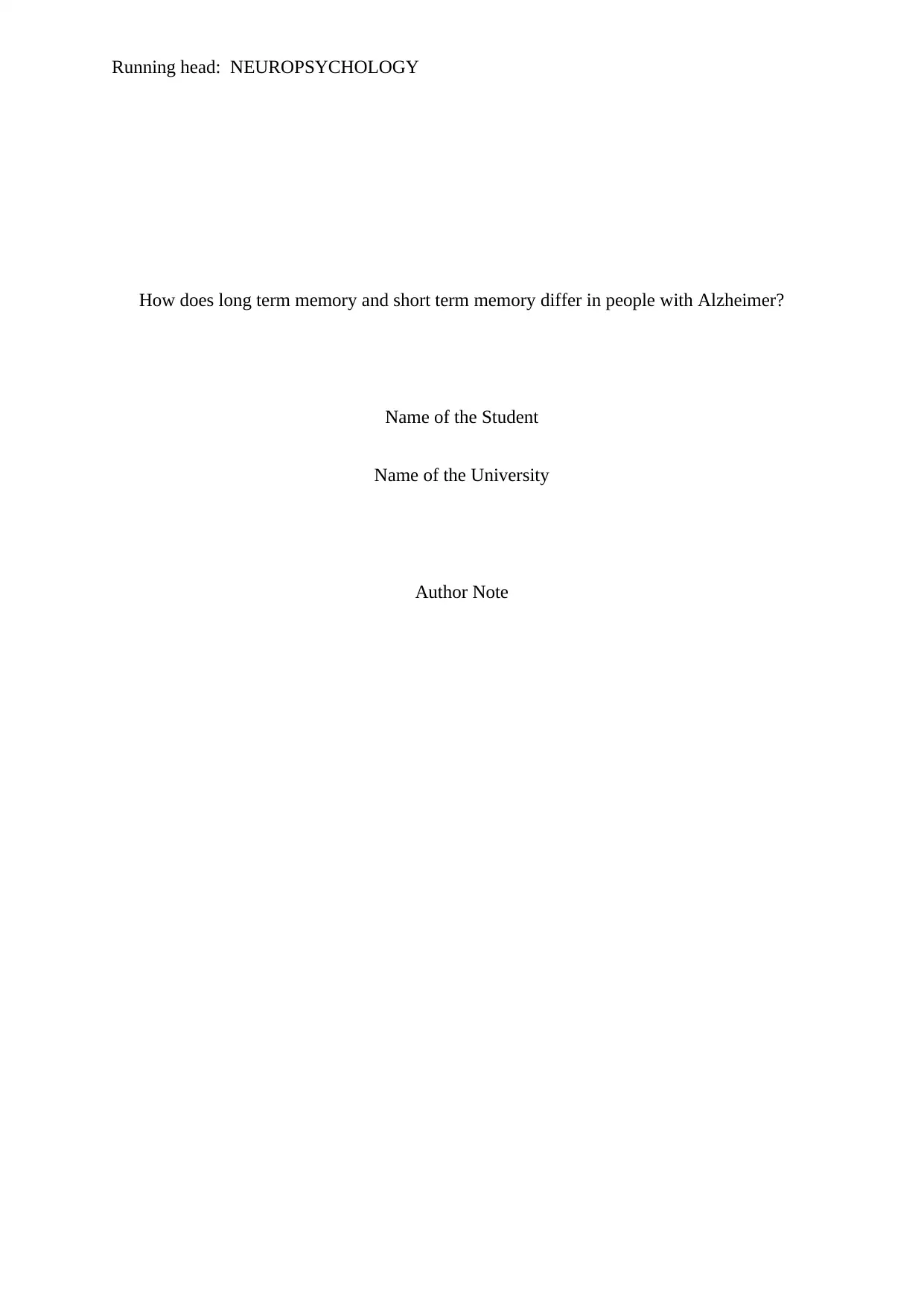
Running head: NEUROPSYCHOLOGY
How does long term memory and short term memory differ in people with Alzheimer?
Name of the Student
Name of the University
Author Note
How does long term memory and short term memory differ in people with Alzheimer?
Name of the Student
Name of the University
Author Note
Paraphrase This Document
Need a fresh take? Get an instant paraphrase of this document with our AI Paraphraser

1
NEUROPSYCHOLOGY
Alzheimer’s Disease
Alzheimer’s is an irreversible, polygenetic neurodegenerative disorder of the brain
that slowly destroys the thinking and the memory skills and eventually hampers the ability to
carry out simple tasks to sustain activities of daily living. The symptoms of Alzheimer’s
disease (AD) first appear after 65 years of age. AD is also regarded as one of the most
common cause of dementia among the older adults. In dementia there occurs loss of cognitive
functioning like remembering, thinking and logical reasoning along with problem in
executing normal behavioural abilities (Bloom, 2014).
Pathophysiology of AD
The change or the damage in brain of individuals with AD starts a decade before the
problems like memory loss and cognition loss surfaces. The changes in the AD mainly occur
in the nerve cells of the brain. Brain has approximately 100 billion nerve cells (neurons).
Each nerve connects with the other in order to form interconnected networks of neurons. The
onset of the AD takes place by the formation and subsequent deposition of the bet-amyloid
protein known as senile plaques and twisted tangles of protein know as tau proteins in
between the spaces of the nerve cells (Bloom, 2014). The deposition of the beta-amyloid
protein in between the spaces of the nerve cell networks hamper propagation of the neuronal
impulses through the nerve endings (synapse) and thereby hamper the normal functioning of
the nerve leading to eventual aopotsis of the nerve cells. The amyloid proteins surround with
dead nerve cells look like plaques. Amyloid plaques are made of amyloid fibrils named after
beta amyloid peptides. Beta amyloid peptide (A-beta) is a 770 segment residue of the
transmembrane protein amyloid beta precursor protein (beta-PP) which is 1770 aminio acid
long (Šimić et al., 2016). Beta amyloid protein is excised from beta-PP by the action of the
two membrane anchored proteolytic enzyme known as beta and gama secretase. However,
NEUROPSYCHOLOGY
Alzheimer’s Disease
Alzheimer’s is an irreversible, polygenetic neurodegenerative disorder of the brain
that slowly destroys the thinking and the memory skills and eventually hampers the ability to
carry out simple tasks to sustain activities of daily living. The symptoms of Alzheimer’s
disease (AD) first appear after 65 years of age. AD is also regarded as one of the most
common cause of dementia among the older adults. In dementia there occurs loss of cognitive
functioning like remembering, thinking and logical reasoning along with problem in
executing normal behavioural abilities (Bloom, 2014).
Pathophysiology of AD
The change or the damage in brain of individuals with AD starts a decade before the
problems like memory loss and cognition loss surfaces. The changes in the AD mainly occur
in the nerve cells of the brain. Brain has approximately 100 billion nerve cells (neurons).
Each nerve connects with the other in order to form interconnected networks of neurons. The
onset of the AD takes place by the formation and subsequent deposition of the bet-amyloid
protein known as senile plaques and twisted tangles of protein know as tau proteins in
between the spaces of the nerve cells (Bloom, 2014). The deposition of the beta-amyloid
protein in between the spaces of the nerve cell networks hamper propagation of the neuronal
impulses through the nerve endings (synapse) and thereby hamper the normal functioning of
the nerve leading to eventual aopotsis of the nerve cells. The amyloid proteins surround with
dead nerve cells look like plaques. Amyloid plaques are made of amyloid fibrils named after
beta amyloid peptides. Beta amyloid peptide (A-beta) is a 770 segment residue of the
transmembrane protein amyloid beta precursor protein (beta-PP) which is 1770 aminio acid
long (Šimić et al., 2016). Beta amyloid protein is excised from beta-PP by the action of the
two membrane anchored proteolytic enzyme known as beta and gama secretase. However,
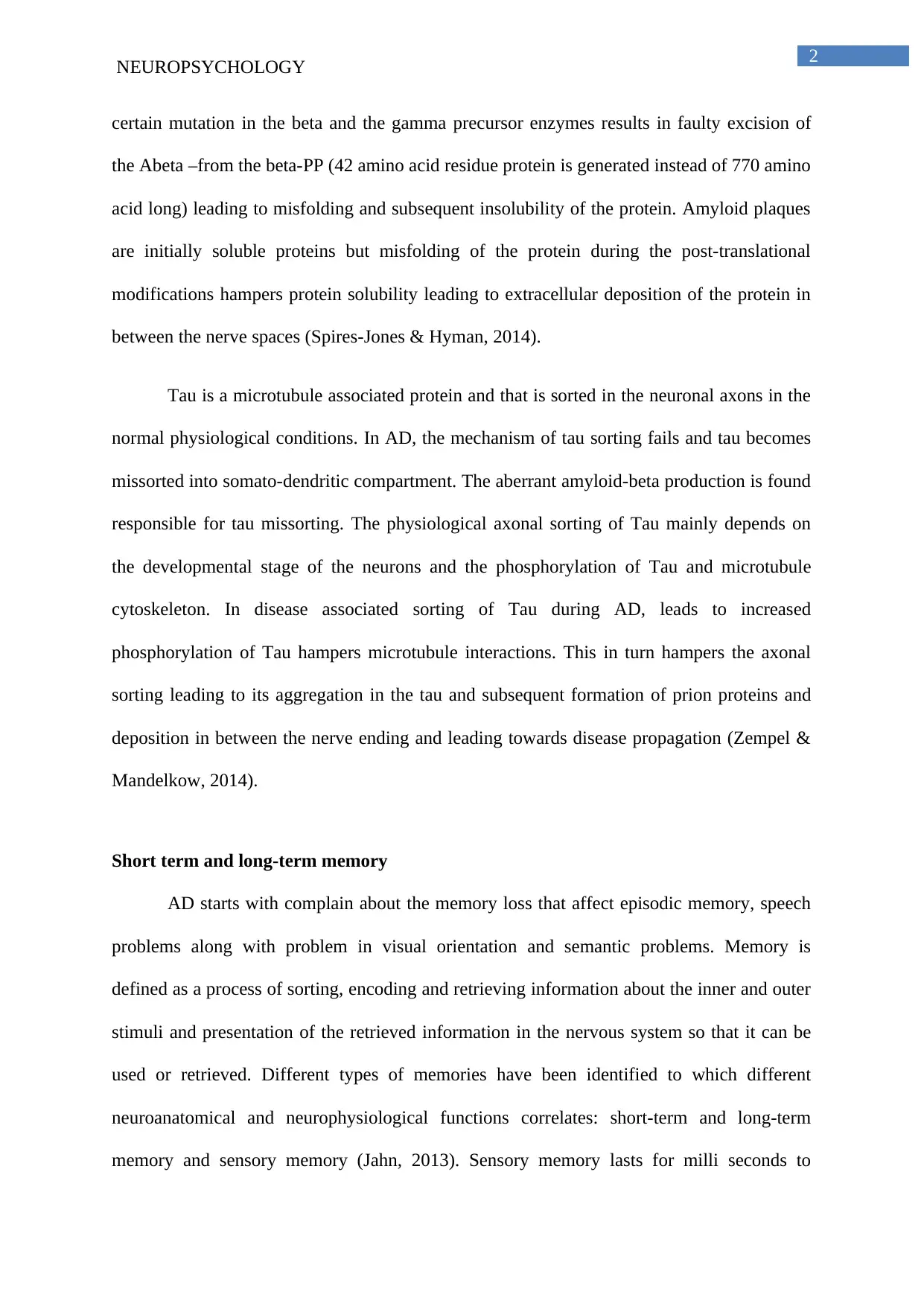
2
NEUROPSYCHOLOGY
certain mutation in the beta and the gamma precursor enzymes results in faulty excision of
the Abeta –from the beta-PP (42 amino acid residue protein is generated instead of 770 amino
acid long) leading to misfolding and subsequent insolubility of the protein. Amyloid plaques
are initially soluble proteins but misfolding of the protein during the post-translational
modifications hampers protein solubility leading to extracellular deposition of the protein in
between the nerve spaces (Spires-Jones & Hyman, 2014).
Tau is a microtubule associated protein and that is sorted in the neuronal axons in the
normal physiological conditions. In AD, the mechanism of tau sorting fails and tau becomes
missorted into somato-dendritic compartment. The aberrant amyloid-beta production is found
responsible for tau missorting. The physiological axonal sorting of Tau mainly depends on
the developmental stage of the neurons and the phosphorylation of Tau and microtubule
cytoskeleton. In disease associated sorting of Tau during AD, leads to increased
phosphorylation of Tau hampers microtubule interactions. This in turn hampers the axonal
sorting leading to its aggregation in the tau and subsequent formation of prion proteins and
deposition in between the nerve ending and leading towards disease propagation (Zempel &
Mandelkow, 2014).
Short term and long-term memory
AD starts with complain about the memory loss that affect episodic memory, speech
problems along with problem in visual orientation and semantic problems. Memory is
defined as a process of sorting, encoding and retrieving information about the inner and outer
stimuli and presentation of the retrieved information in the nervous system so that it can be
used or retrieved. Different types of memories have been identified to which different
neuroanatomical and neurophysiological functions correlates: short-term and long-term
memory and sensory memory (Jahn, 2013). Sensory memory lasts for milli seconds to
NEUROPSYCHOLOGY
certain mutation in the beta and the gamma precursor enzymes results in faulty excision of
the Abeta –from the beta-PP (42 amino acid residue protein is generated instead of 770 amino
acid long) leading to misfolding and subsequent insolubility of the protein. Amyloid plaques
are initially soluble proteins but misfolding of the protein during the post-translational
modifications hampers protein solubility leading to extracellular deposition of the protein in
between the nerve spaces (Spires-Jones & Hyman, 2014).
Tau is a microtubule associated protein and that is sorted in the neuronal axons in the
normal physiological conditions. In AD, the mechanism of tau sorting fails and tau becomes
missorted into somato-dendritic compartment. The aberrant amyloid-beta production is found
responsible for tau missorting. The physiological axonal sorting of Tau mainly depends on
the developmental stage of the neurons and the phosphorylation of Tau and microtubule
cytoskeleton. In disease associated sorting of Tau during AD, leads to increased
phosphorylation of Tau hampers microtubule interactions. This in turn hampers the axonal
sorting leading to its aggregation in the tau and subsequent formation of prion proteins and
deposition in between the nerve ending and leading towards disease propagation (Zempel &
Mandelkow, 2014).
Short term and long-term memory
AD starts with complain about the memory loss that affect episodic memory, speech
problems along with problem in visual orientation and semantic problems. Memory is
defined as a process of sorting, encoding and retrieving information about the inner and outer
stimuli and presentation of the retrieved information in the nervous system so that it can be
used or retrieved. Different types of memories have been identified to which different
neuroanatomical and neurophysiological functions correlates: short-term and long-term
memory and sensory memory (Jahn, 2013). Sensory memory lasts for milli seconds to
⊘ This is a preview!⊘
Do you want full access?
Subscribe today to unlock all pages.

Trusted by 1+ million students worldwide
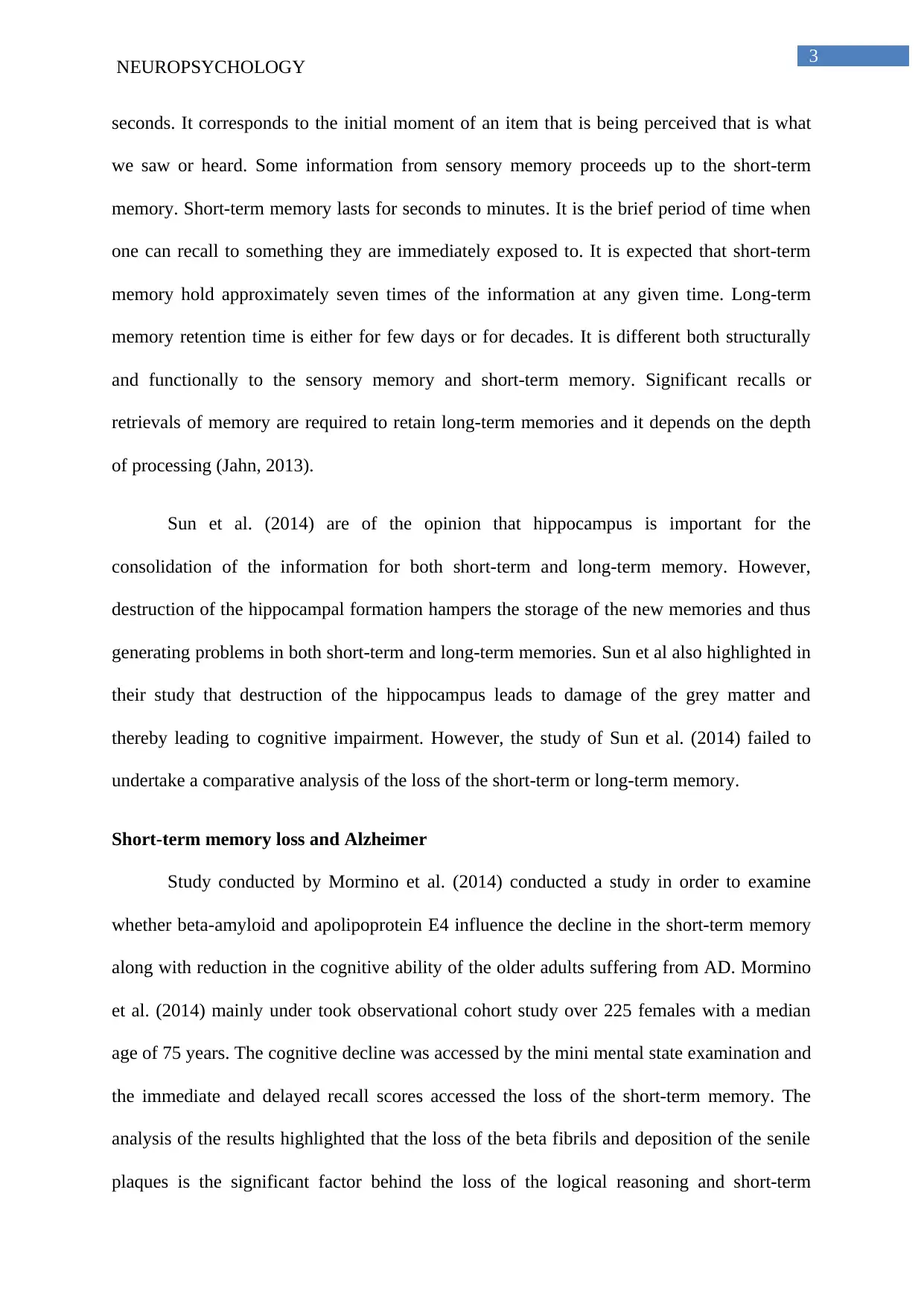
3
NEUROPSYCHOLOGY
seconds. It corresponds to the initial moment of an item that is being perceived that is what
we saw or heard. Some information from sensory memory proceeds up to the short-term
memory. Short-term memory lasts for seconds to minutes. It is the brief period of time when
one can recall to something they are immediately exposed to. It is expected that short-term
memory hold approximately seven times of the information at any given time. Long-term
memory retention time is either for few days or for decades. It is different both structurally
and functionally to the sensory memory and short-term memory. Significant recalls or
retrievals of memory are required to retain long-term memories and it depends on the depth
of processing (Jahn, 2013).
Sun et al. (2014) are of the opinion that hippocampus is important for the
consolidation of the information for both short-term and long-term memory. However,
destruction of the hippocampal formation hampers the storage of the new memories and thus
generating problems in both short-term and long-term memories. Sun et al also highlighted in
their study that destruction of the hippocampus leads to damage of the grey matter and
thereby leading to cognitive impairment. However, the study of Sun et al. (2014) failed to
undertake a comparative analysis of the loss of the short-term or long-term memory.
Short-term memory loss and Alzheimer
Study conducted by Mormino et al. (2014) conducted a study in order to examine
whether beta-amyloid and apolipoprotein E4 influence the decline in the short-term memory
along with reduction in the cognitive ability of the older adults suffering from AD. Mormino
et al. (2014) mainly under took observational cohort study over 225 females with a median
age of 75 years. The cognitive decline was accessed by the mini mental state examination and
the immediate and delayed recall scores accessed the loss of the short-term memory. The
analysis of the results highlighted that the loss of the beta fibrils and deposition of the senile
plaques is the significant factor behind the loss of the logical reasoning and short-term
NEUROPSYCHOLOGY
seconds. It corresponds to the initial moment of an item that is being perceived that is what
we saw or heard. Some information from sensory memory proceeds up to the short-term
memory. Short-term memory lasts for seconds to minutes. It is the brief period of time when
one can recall to something they are immediately exposed to. It is expected that short-term
memory hold approximately seven times of the information at any given time. Long-term
memory retention time is either for few days or for decades. It is different both structurally
and functionally to the sensory memory and short-term memory. Significant recalls or
retrievals of memory are required to retain long-term memories and it depends on the depth
of processing (Jahn, 2013).
Sun et al. (2014) are of the opinion that hippocampus is important for the
consolidation of the information for both short-term and long-term memory. However,
destruction of the hippocampal formation hampers the storage of the new memories and thus
generating problems in both short-term and long-term memories. Sun et al also highlighted in
their study that destruction of the hippocampus leads to damage of the grey matter and
thereby leading to cognitive impairment. However, the study of Sun et al. (2014) failed to
undertake a comparative analysis of the loss of the short-term or long-term memory.
Short-term memory loss and Alzheimer
Study conducted by Mormino et al. (2014) conducted a study in order to examine
whether beta-amyloid and apolipoprotein E4 influence the decline in the short-term memory
along with reduction in the cognitive ability of the older adults suffering from AD. Mormino
et al. (2014) mainly under took observational cohort study over 225 females with a median
age of 75 years. The cognitive decline was accessed by the mini mental state examination and
the immediate and delayed recall scores accessed the loss of the short-term memory. The
analysis of the results highlighted that the loss of the beta fibrils and deposition of the senile
plaques is the significant factor behind the loss of the logical reasoning and short-term
Paraphrase This Document
Need a fresh take? Get an instant paraphrase of this document with our AI Paraphraser

4
NEUROPSYCHOLOGY
memory among the AD patients. On the other hand, loss of apolipoprotein E4 leads to
progressive loss of the cognitive thinking skills. However, the cognitive impairment is found
to be higher in comparison to the short-term memory loss (Mormino et al., 2014). The main
drawback of the study is, it is conducted solely over the women and thus creating a barrier of
the generalization of the data over the two different gender. Moreover, cognitive impairment
occurs in the older adults who ate over 70 years of age irrespective of the development of the
AD and thus indicating the chances of confounding bias (Trzepacz et al., 2015).
Long-term memory loss and Alzheimer
Study conducted by Dong et al. (2015) highlighted an association between the long-
term potentiation (LTP) of the synaptic strength and hippocampus neurons. The dysfunction
of the LTP leads to the loss of long-term memory. Initially there was limited knowledge
about how the decaying or LTP is related with the loss of memory in Ad patients. The study
conducted by Dong et al. (2015) revealed that inhibition of the endocytosis of postsynaptic
alpha-amino-3-hydroxy-5-isoxazole-4-propionic acid receptors (AMPARs) prevents the
decay to LTP and thereby helping to convert LTP into its non-decaying counterpart.
However, in case of AD, the restoration of AMPAR endocytosis is hampered through the
inhibition of the protein kinase leading to decay to LTP. Decay in LTP is found to hamper the
memory retention as highlighted in the murine model of AD. The loss of neurophysical
mapping mainly highlighted that the loss of memory is pronounced in the domain of long-
term memory. However, the drawback of the study is, it was conducted in over the mouse
model and thus still on the initial stages to gave the exact physiological and pathological
interpretation on the human begins.
Moreno-Castilla et al. (2016) mainly studied how the failure in the transmission of the
synaptic impulses leads to loss of memory among the older adults with AD. They mainly
studied the role of the synaptic plasticity and dopaminergic neurotransmission towards
NEUROPSYCHOLOGY
memory among the AD patients. On the other hand, loss of apolipoprotein E4 leads to
progressive loss of the cognitive thinking skills. However, the cognitive impairment is found
to be higher in comparison to the short-term memory loss (Mormino et al., 2014). The main
drawback of the study is, it is conducted solely over the women and thus creating a barrier of
the generalization of the data over the two different gender. Moreover, cognitive impairment
occurs in the older adults who ate over 70 years of age irrespective of the development of the
AD and thus indicating the chances of confounding bias (Trzepacz et al., 2015).
Long-term memory loss and Alzheimer
Study conducted by Dong et al. (2015) highlighted an association between the long-
term potentiation (LTP) of the synaptic strength and hippocampus neurons. The dysfunction
of the LTP leads to the loss of long-term memory. Initially there was limited knowledge
about how the decaying or LTP is related with the loss of memory in Ad patients. The study
conducted by Dong et al. (2015) revealed that inhibition of the endocytosis of postsynaptic
alpha-amino-3-hydroxy-5-isoxazole-4-propionic acid receptors (AMPARs) prevents the
decay to LTP and thereby helping to convert LTP into its non-decaying counterpart.
However, in case of AD, the restoration of AMPAR endocytosis is hampered through the
inhibition of the protein kinase leading to decay to LTP. Decay in LTP is found to hamper the
memory retention as highlighted in the murine model of AD. The loss of neurophysical
mapping mainly highlighted that the loss of memory is pronounced in the domain of long-
term memory. However, the drawback of the study is, it was conducted in over the mouse
model and thus still on the initial stages to gave the exact physiological and pathological
interpretation on the human begins.
Moreno-Castilla et al. (2016) mainly studied how the failure in the transmission of the
synaptic impulses leads to loss of memory among the older adults with AD. They mainly
studied the role of the synaptic plasticity and dopaminergic neurotransmission towards
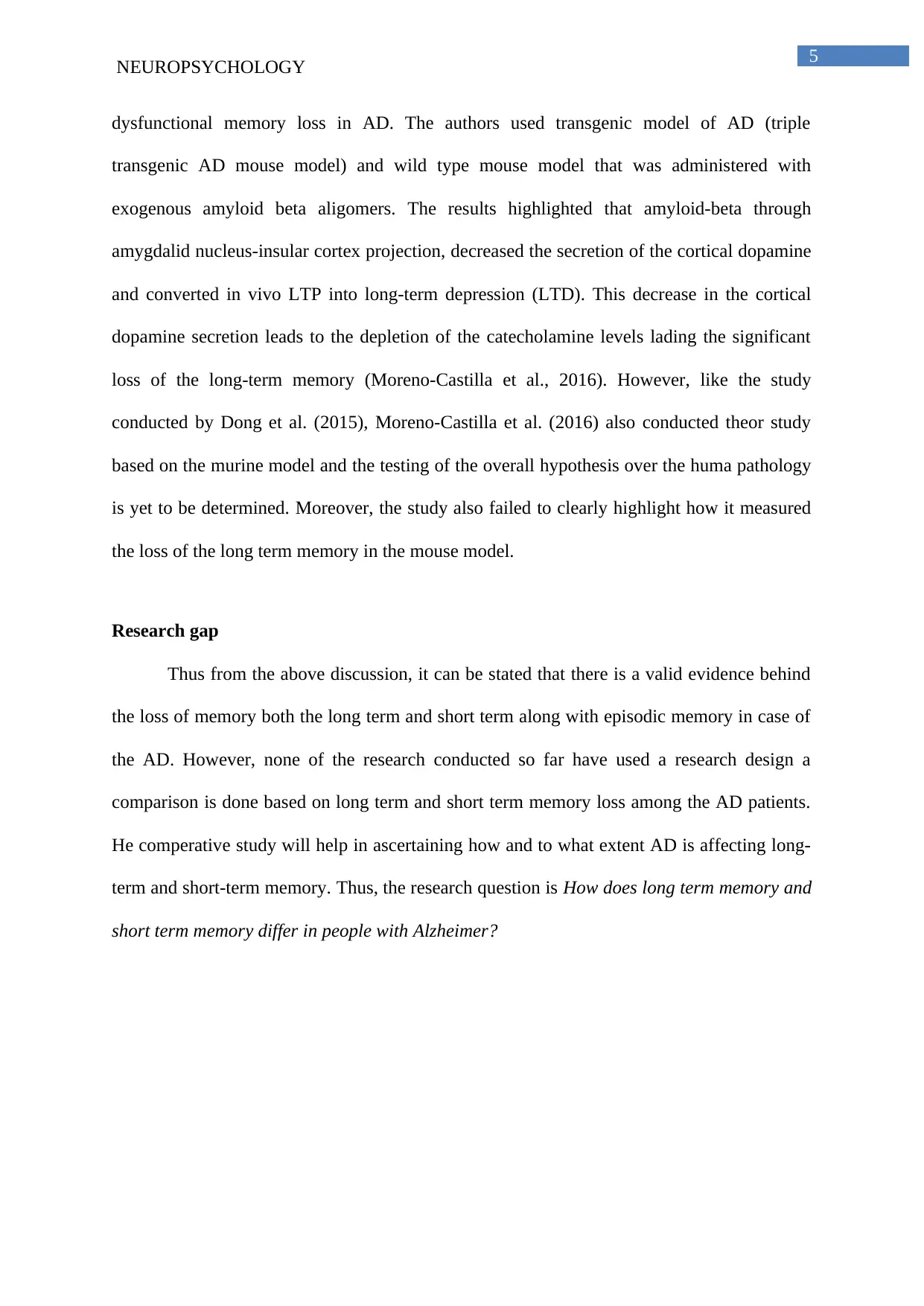
5
NEUROPSYCHOLOGY
dysfunctional memory loss in AD. The authors used transgenic model of AD (triple
transgenic AD mouse model) and wild type mouse model that was administered with
exogenous amyloid beta aligomers. The results highlighted that amyloid-beta through
amygdalid nucleus-insular cortex projection, decreased the secretion of the cortical dopamine
and converted in vivo LTP into long-term depression (LTD). This decrease in the cortical
dopamine secretion leads to the depletion of the catecholamine levels lading the significant
loss of the long-term memory (Moreno-Castilla et al., 2016). However, like the study
conducted by Dong et al. (2015), Moreno-Castilla et al. (2016) also conducted theor study
based on the murine model and the testing of the overall hypothesis over the huma pathology
is yet to be determined. Moreover, the study also failed to clearly highlight how it measured
the loss of the long term memory in the mouse model.
Research gap
Thus from the above discussion, it can be stated that there is a valid evidence behind
the loss of memory both the long term and short term along with episodic memory in case of
the AD. However, none of the research conducted so far have used a research design a
comparison is done based on long term and short term memory loss among the AD patients.
He comperative study will help in ascertaining how and to what extent AD is affecting long-
term and short-term memory. Thus, the research question is How does long term memory and
short term memory differ in people with Alzheimer?
NEUROPSYCHOLOGY
dysfunctional memory loss in AD. The authors used transgenic model of AD (triple
transgenic AD mouse model) and wild type mouse model that was administered with
exogenous amyloid beta aligomers. The results highlighted that amyloid-beta through
amygdalid nucleus-insular cortex projection, decreased the secretion of the cortical dopamine
and converted in vivo LTP into long-term depression (LTD). This decrease in the cortical
dopamine secretion leads to the depletion of the catecholamine levels lading the significant
loss of the long-term memory (Moreno-Castilla et al., 2016). However, like the study
conducted by Dong et al. (2015), Moreno-Castilla et al. (2016) also conducted theor study
based on the murine model and the testing of the overall hypothesis over the huma pathology
is yet to be determined. Moreover, the study also failed to clearly highlight how it measured
the loss of the long term memory in the mouse model.
Research gap
Thus from the above discussion, it can be stated that there is a valid evidence behind
the loss of memory both the long term and short term along with episodic memory in case of
the AD. However, none of the research conducted so far have used a research design a
comparison is done based on long term and short term memory loss among the AD patients.
He comperative study will help in ascertaining how and to what extent AD is affecting long-
term and short-term memory. Thus, the research question is How does long term memory and
short term memory differ in people with Alzheimer?
⊘ This is a preview!⊘
Do you want full access?
Subscribe today to unlock all pages.

Trusted by 1+ million students worldwide
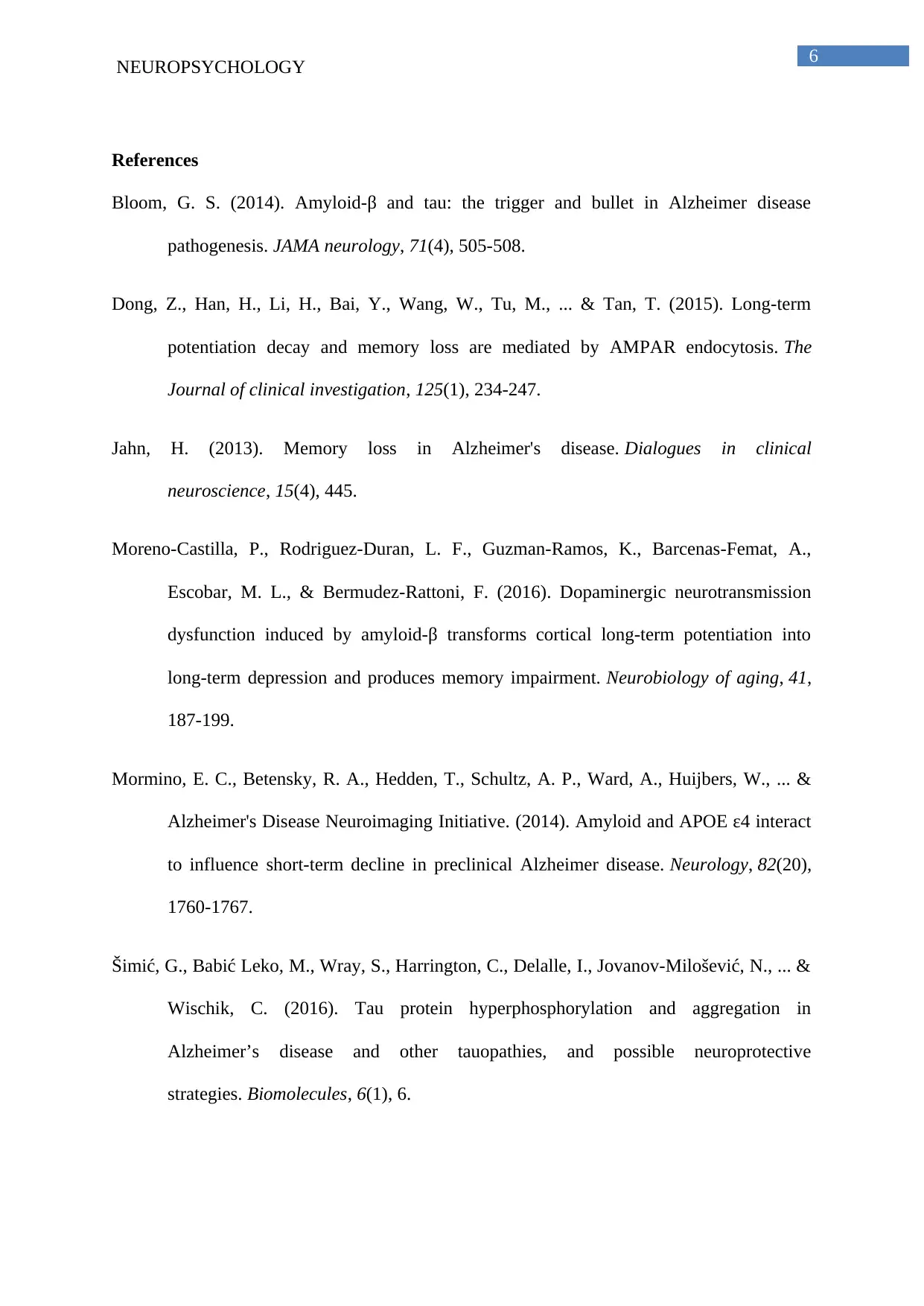
6
NEUROPSYCHOLOGY
References
Bloom, G. S. (2014). Amyloid-β and tau: the trigger and bullet in Alzheimer disease
pathogenesis. JAMA neurology, 71(4), 505-508.
Dong, Z., Han, H., Li, H., Bai, Y., Wang, W., Tu, M., ... & Tan, T. (2015). Long-term
potentiation decay and memory loss are mediated by AMPAR endocytosis. The
Journal of clinical investigation, 125(1), 234-247.
Jahn, H. (2013). Memory loss in Alzheimer's disease. Dialogues in clinical
neuroscience, 15(4), 445.
Moreno-Castilla, P., Rodriguez-Duran, L. F., Guzman-Ramos, K., Barcenas-Femat, A.,
Escobar, M. L., & Bermudez-Rattoni, F. (2016). Dopaminergic neurotransmission
dysfunction induced by amyloid-β transforms cortical long-term potentiation into
long-term depression and produces memory impairment. Neurobiology of aging, 41,
187-199.
Mormino, E. C., Betensky, R. A., Hedden, T., Schultz, A. P., Ward, A., Huijbers, W., ... &
Alzheimer's Disease Neuroimaging Initiative. (2014). Amyloid and APOE ε4 interact
to influence short-term decline in preclinical Alzheimer disease. Neurology, 82(20),
1760-1767.
Šimić, G., Babić Leko, M., Wray, S., Harrington, C., Delalle, I., Jovanov-Milošević, N., ... &
Wischik, C. (2016). Tau protein hyperphosphorylation and aggregation in
Alzheimer’s disease and other tauopathies, and possible neuroprotective
strategies. Biomolecules, 6(1), 6.
NEUROPSYCHOLOGY
References
Bloom, G. S. (2014). Amyloid-β and tau: the trigger and bullet in Alzheimer disease
pathogenesis. JAMA neurology, 71(4), 505-508.
Dong, Z., Han, H., Li, H., Bai, Y., Wang, W., Tu, M., ... & Tan, T. (2015). Long-term
potentiation decay and memory loss are mediated by AMPAR endocytosis. The
Journal of clinical investigation, 125(1), 234-247.
Jahn, H. (2013). Memory loss in Alzheimer's disease. Dialogues in clinical
neuroscience, 15(4), 445.
Moreno-Castilla, P., Rodriguez-Duran, L. F., Guzman-Ramos, K., Barcenas-Femat, A.,
Escobar, M. L., & Bermudez-Rattoni, F. (2016). Dopaminergic neurotransmission
dysfunction induced by amyloid-β transforms cortical long-term potentiation into
long-term depression and produces memory impairment. Neurobiology of aging, 41,
187-199.
Mormino, E. C., Betensky, R. A., Hedden, T., Schultz, A. P., Ward, A., Huijbers, W., ... &
Alzheimer's Disease Neuroimaging Initiative. (2014). Amyloid and APOE ε4 interact
to influence short-term decline in preclinical Alzheimer disease. Neurology, 82(20),
1760-1767.
Šimić, G., Babić Leko, M., Wray, S., Harrington, C., Delalle, I., Jovanov-Milošević, N., ... &
Wischik, C. (2016). Tau protein hyperphosphorylation and aggregation in
Alzheimer’s disease and other tauopathies, and possible neuroprotective
strategies. Biomolecules, 6(1), 6.
Paraphrase This Document
Need a fresh take? Get an instant paraphrase of this document with our AI Paraphraser

7
NEUROPSYCHOLOGY
Spires-Jones, T. L., & Hyman, B. T. (2014). The intersection of amyloid beta and tau at
synapses in Alzheimer’s disease. Neuron, 82(4), 756-771.
Sun, X., Salat, D., Upchurch, K., Deason, R., Kowall, N., & Budson, A. (2014). Destruction
of white matter integrity in patients with mild cognitive impairment and Alzheimer
disease. Journal of Investigative Medicine, 62(7), 927-933.
Trzepacz, P. T., Hochstetler, H., Wang, S., Walker, B., & Saykin, A. J. (2015). Relationship
between the Montreal Cognitive Assessment and Mini-mental State Examination for
assessment of mild cognitive impairment in older adults. BMC geriatrics, 15(1), 107.
Zempel, H., & Mandelkow, E. (2014). Lost after translation: missorting of Tau protein and
consequences for Alzheimer disease. Trends in neurosciences, 37(12), 721-732.
NEUROPSYCHOLOGY
Spires-Jones, T. L., & Hyman, B. T. (2014). The intersection of amyloid beta and tau at
synapses in Alzheimer’s disease. Neuron, 82(4), 756-771.
Sun, X., Salat, D., Upchurch, K., Deason, R., Kowall, N., & Budson, A. (2014). Destruction
of white matter integrity in patients with mild cognitive impairment and Alzheimer
disease. Journal of Investigative Medicine, 62(7), 927-933.
Trzepacz, P. T., Hochstetler, H., Wang, S., Walker, B., & Saykin, A. J. (2015). Relationship
between the Montreal Cognitive Assessment and Mini-mental State Examination for
assessment of mild cognitive impairment in older adults. BMC geriatrics, 15(1), 107.
Zempel, H., & Mandelkow, E. (2014). Lost after translation: missorting of Tau protein and
consequences for Alzheimer disease. Trends in neurosciences, 37(12), 721-732.
1 out of 8
Related Documents
Your All-in-One AI-Powered Toolkit for Academic Success.
+13062052269
info@desklib.com
Available 24*7 on WhatsApp / Email
![[object Object]](/_next/static/media/star-bottom.7253800d.svg)
Unlock your academic potential
Copyright © 2020–2025 A2Z Services. All Rights Reserved. Developed and managed by ZUCOL.





